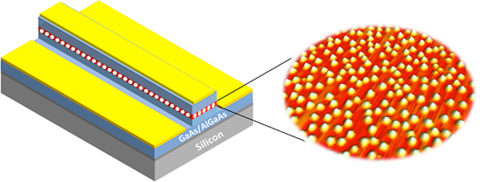Quantum dot semiconductor lasers
Quantum dots are tiny semiconductor particles a few nanometres in size, having optical and electronic properties that differ from larger particles due to quantum effects. They are a central topic in nano-technology.
A quantum dot laser is a semiconductor laser that uses quantum dots as the active laser material in its light emitting region. Due to the tight confinement of charge carriers in quantum dots, they exhibit an electronic structure similar to atoms. Lasers fabricated from such an active media exhibit device performance that is closer to gas lasers and avoid some of the negative aspects of device performance associated with traditional semiconductor lasers based on bulk active media. By varying dot size and composition quantum dot lasers can operate at wavelengths previously not possible using semiconductor laser technology.
Quantum dot lasers are finding commercial applications in medicine, display technologies, spectroscopy and tele-communications. Quantum dot lasers that are insensitive to temperature fluctuations are ideal for use in optical data communications and networks.

Fig. 7: Schematic diagram of a quantum dot laser
In a collaboration with G. D’Alessandro (Southampton) and G.L. Lippi (Nice, France), the CNQO group is now working on the combination of quantum and nonlinear features of the lasing operation of quantum dot lasers. Theory and simulations are capable to explain, for example, the possibility of regimes of threshold-less laser action that can improve the energy-efficiency of these devices.
Reference
Y. Ota et al, Thresholdless quantum dot nanolaser, Opt. Express 25, 19981 (2017).